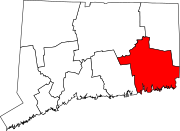Waterford, Connecticut
[2] The town center is listed as a census-designated place (CDP) and had a population of 3,074 at the 2020 census.
[4] The town center CDP has a total area of 1.9 square miles (4.9 km2), all land.
Other minor communities and geographic features are Cohanzie Hill, East Neck, Fog Plain, Gilead, Goshen, Great Neck, Harrisons, Lake's Pond, Logger Hill, Mago Point, Magonk, Mullen Hill, Oswegatchie, Pepperbox Road, Pleasure Beach, Ridgewood Park, Riverside Beach, Spithead, Strand, West Neck, Waterford Village.
The first people immigrated from England in 1637 and came to the New London and Waterford area (at the time, this land was called West Farms).
One of the first people who set sail for this area was John Winthrop Jr. Waterford got its name for its proximity to being in between two rivers.
Winthrop was given several hundred acres of land, including Millstone Point and Alewife Cove.
The only expansion of people in the Waterford-New London area were the growth of families and children.
Later on, more people immigrated to Waterford, including Welsh, Italian, Russian, Irish, and Scottish.
[5] Waterford was a large agricultural town in the 19th century, having mostly sheep farms.
Waterford's granite was used in many construction projects such as roads, the foundation for Fort Sumter, and the Statue of Liberty.
[10] At the 2010 census,[11] there were 2,887 people in 1,327 households, including 732 families, in the Waterford census-designated place, comprising the town center.
Earlier, a lot was set aside for Quaker Hill in 1725 while the town was split into three districts: "Neck and Nehantick quarters," "West," and the "North East."
Farmers mainly wanted their children to be taught writing, reading, arithmetic, and religion.
Private lessons were of no need in Waterford, but were set up in the 19th century for those who had enough money to afford it.
The Jordan School's last day of teaching was in the year 1979 with a final assembly.
[16][17] Waterford's local government is structured using a representative town meeting system.
While Millstone's first reactor is no longer in operation, the remaining two still provide power to a variety of towns in New England.
"[26] According to 2012 statistics, the crime rate in Waterford is below average compared to most cities in the United States.
The Waterford Ambulance Service (WAS) is a non-profit ambulance service providing emergency medical care to the residents and visitors of the Town of Waterford, Connecticut and surrounding communities with emergency medical services and ambulance transportation in accordance with established Federal and State laws and regulations.





